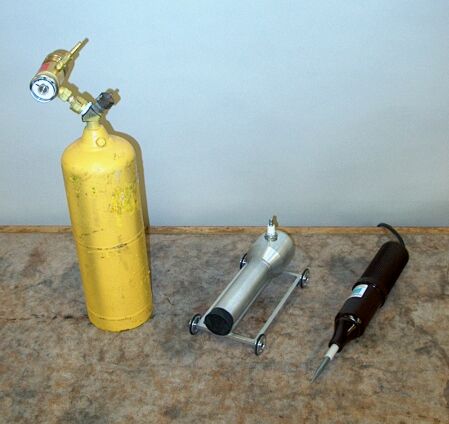
Remove the rubber stopper from the mouth of the cannon. Place the mouth of the cannon over the spout of the acetylene tank. (Acetylene, at ~26 g/mol, is slightly less dense than air, whose density is ~29 g/mol.) Open the valve slightly, then quickly close it, to release a small amount of gas into the cannon. Replace the rubber stopper tightly into the mouth of the cannon. (This is usually done before class time.) Place the cannon on the floor (NOT on the main demonstration table). Ignite the gas by turning on the Tesla coil and touching it to the spark plug at the rear of the cannon.
This demonstration provides an illustration of Newton’s third law of motion, which states (as quoted in Resnick, Robert and Halliday, David. Physics, Part 1, Third Edition (New York: John Wiley and Sons, 1977), p. 79) To every action there is always opposed an equal reaction; or, the mutual actions of two bodies upon each other are always equal, and directed to contrary parts.
The purpose of a cannon is to launch a projectile at high enough speed that it can reach a target some distance away. The cannon, in exerting the force on the cannonball (or other projectile) that accelerates it and sends it flying out of the muzzle, itself suffers a force in the opposite direction, which accelerates the cannon backwards – in the opposite direction to that of the cannonball. Actually, when cannon (or other types of gun) are used, they are aimed upwards, so that the force along the axis of the cannon has both a vertical and a horizontal component. The cannon in this demonstration, however, points horizontally, so that the force on both the stopper and the cannon is purely horizontal. This force imparts an acceleration to each part of the system, that is inversely proportional to its mass (F = ma) Since the stopper is significantly less massive than the cannon, the acceleration that it undergoes is much higher than that of the cannon, so it shoots out at fairly high speed, while the cannon gently rolls backwards.
Initially, the cannon and stopper are standing still, so their total momentum (mv, which equals mcvc + msvs, where the subscript “c” denotes “cannon” and the subscript “s” denotes “stopper”) is zero. Since no net external forces act on the cannon or stopper, after you fire the cannon, the total momentum must still equal zero, and mcvc = -msvs. (And (vc/vs) = -(ms/mc).) Thus, as noted above, the velocities of the cannon and the stopper are opposite, and in inverse proportion to their masses. Also, the location of the center of mass of the cannon/stopper system cannot move when you fire the cannon. Thus, wherever the center of mass of the system is when you set the cannon on the floor, at any time after you fire the cannon, the positions of the cannon and stopper must be such that their moments about that point sum to zero.
Because the stopper and cannon go off at different speeds, the explosion that separates them does not do the same work on each. To determine how the kinetic energy they acquire is apportioned between them, we must use the fact that momentum is conserved. If we call the cannon’s kinetic energy Kc (= (1/2) mcvc2), and that of the stopper Ks (= (1/2) msvs2), then Kc/Ks = [(1/2) mcvc2)/(1/2) msvs2)]. Substituting -(ms/mc) vs for vc, and -(mc/ms) vc for vs, and canceling the (1/2) terms, gives Kc/Ks = [-mc((ms/mc) vs)2/-ms((mc/ms) vc)2], or Kc/Ks = [ms(msvs)2/mc(mcvc)2]. The two squared terms are the squares of the momenta of the cannon and the stopper, which must be equal, so these cancel, leaving Kc/Ks = (ms/mc). So the cannon and stopper acquire kinetic energy in inverse proportion to their masses.
References:
1) Resnick, Robert and Halliday, David. Physics, Part One, Third Edition (New York: John Wiley and Sons, 1977), pp. 172-3.
2) Sears, Francis Weston and Zemansky, Mark W. College Physics, Third Edition (Reading, Massachussetts: Addison-Wesley Publishing Company, Inc., 1960), pp. 160-1.